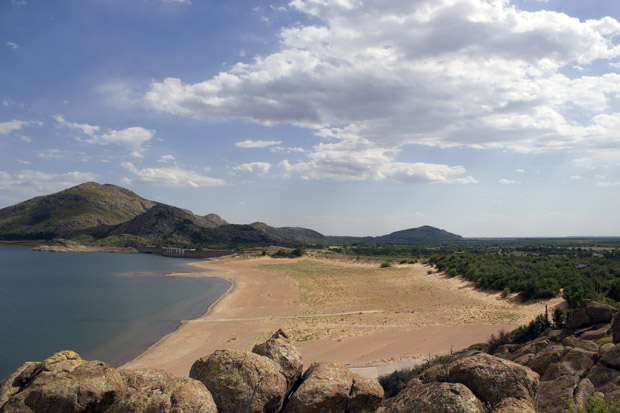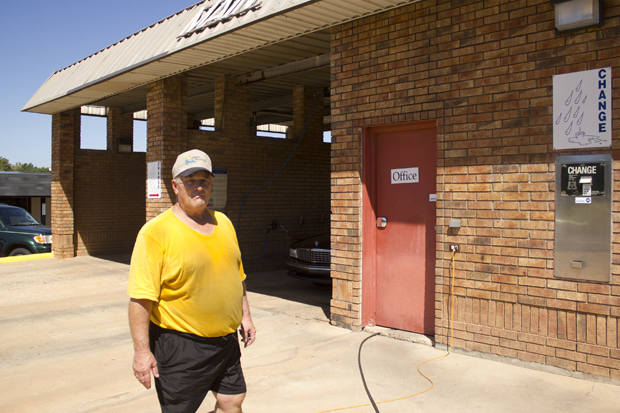
After four years of drought, municipal water storage in in Altus-Lugert lake has dropped to about 10 percent.
Joe Wertz / StateImpact Oklahoma


After four years of drought, municipal water storage in in Altus-Lugert lake has dropped to about 10 percent.
Joe Wertz / StateImpact Oklahoma

Joe Wertz / StateImpact Oklahoma
After four years of drought, municipal water storage in in Altus-Lugert lake has dropped to about 10 percent.
Water supplies in southwest Oklahoma are in danger of drying up as four years of drought drag lake levels to record lows. Some communities are scrambling to supplement their current water sources, while others look for new sources — in Texas.
Estimates say Duncan’s main water source — Lake Waurika — could be too low to use by 2016.
“We’re about a year’s worth of rainfall behind,” Scott Vaughn, public works director for the city of Duncan says. “The city actually owns 100 percent of four other lakes: Clear Creek Lake, Duncan Lake, Lake Fuqua and Lake Humphreys.
“This is the worst I’ve ever seen it. I’ve seen a lot, and I try to conserve every bit of water I can, but it’s hard to do,” Brenny Aldridge worries. His livelihood depends on water. He owns a car wash in Duncan. “You know, they should’ve been five years, ten years behind trying to figure out how to get extra water instead of waiting to get into a crisis. And it won’t happen overnight.”

Logan Layden / StateImpact Oklahoma
Car wash owner Brenny Aldridge outside Main Street Dirt Busters in Duncan.
All five of Duncan’s lakes are critically low. The story is similar in Lawton and Altus. Each city has its own particular problems and plans to address them, but what they have in common is a reliance on lakes that are drying up. And they’re all looking underground for a solution. Rather, they’re looking back underground.
“In the past the city of Lawton had groundwater, but for the last 40 years or so or maybe more, Lawton has relied on surface water,” the City of Lawton’s Afsaneh Jabbar says. “Now we’re looking at groundwater to see if that’s an option for us.”
Before any southwest Oklahoma lakes existed, these same communities relied on water from underground aquifers. After the lakes were built in the ’50s and ’60s, a wet period in Oklahoma’s history kept them full. Groundwater was phased out and its infrastructure left to rot. Acting Altus City Manager Greg Buckley says crews are on it now.

Logan Layden / StateImpact Oklahoma
Afsaneh Jabbar, assistant director for water and wastewater with the Lawton Public Works Department.
“We are in the process of redoing a water line that runs to wells that are south of town,” Buckley says. “They became in disrepair because we really didn’t need them for a while so the city just didn’t maintain them.”
The addition of previously used groundwater sources, replacing century-old pipes and better managing surface water will cost millions of dollars for all three cities, but combined with aggressive conservation and reuse, might be enough to keep Duncan and Lawton afloat even if the drought continues. But the Altus area needs more.
“There is discussion from the Texas panhandle to take and build a pipeline that will go from there, back somewhere there here along Altus, and then back down to the Red River into Texas,” Buckley says.

Logan Layden / StateImpact Oklahoma
Altus business owner Loran Moran outside Altus City Hall after paying a water bill.
“We found an Ogallala Aquifer supply that was untapped and available,” says Larry Roach with Guernsey, the engineering consulting firm behind the idea. “And we started putting together a remanent of a plan where we could provide water not only to north Texas panhandle people who really don’t have a lot of demand, but bring it south and help the southwest Oklahoma communities.”
Given how resistant Oklahoma has been to sharing water with Texas, you’d think they’d be against such a plan, but Roach says the pipeline would also bring more water to Wichita Falls and areas of north Texas that desperately need it.
Outside Altus City Hall, local business owner Loran Mayes fights the wind as she straps her toddler into a car seat. She just hopes the city knows what it’s doing.
“I’m trying to have confidence that the people in this building are working diligently to fix the problem,” Mayes says. “I also own a small business here, and so our income is affected because it’s hard to spend money in a town where there’s no money and no water.”
She says however Altus decides to ensure its water future, it’s important the plan is affordable. That’s a challenge. Just the feasibility study for the Oklahoma-Texas pipeline, the initial step in the process, will cost three-quarters of a million dollars.